Fred Bruche
Member
Eleven gorgeous entries for this contest, THIS IS ART! No special tools required, just artistry and talent. Since we are nearing the end of Bash season, let's get this voting done in 3 days so that no one misses the losers' train! You have 2 votes.
Entry#1 Materials- Cocobolo, red plastic, and dendritic soapstone for the blank, a polaris tip and clip. I glued a 7mm tube inside a Polaris tip and unscrewed it. Then drilled out my blank and glued it on. For the back I used a closed-end mandrel. Gave it all a CA finish.
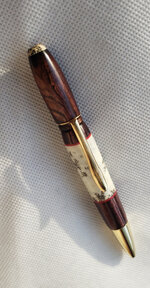
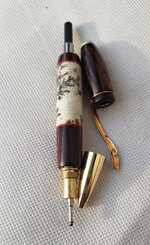
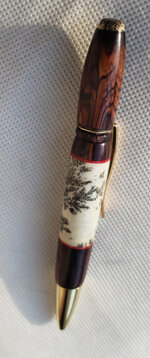
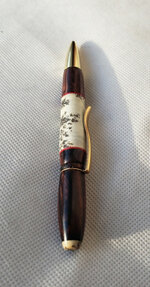
Entry#2 Acrylic blank and funline kit. My objective was to make a high-end-looking ballpoint pen with a minimum of modifications. My modifications included making the lower barrel longer, eliminating the center band, and carefully developing the contours of the barrels.
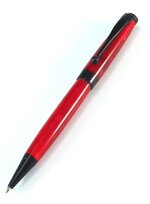
Entry#3 PSI Gold Pen kit - the only gold one I had. I have 11 different species of wood in this pen, although you cannot see them all: Cocobolo, Mahogony, Ash, Maple, Bocote, Wenge, Maple, Cedar, Walnut, African Blackwood, and what I think is Yellowheart. For the finish, I used Tung oil, EEE paste, and Pens plus. After I segmented a different pen for a different contest here, I had a thought for another pen. What would happen if I stacked these pieces together. I cut the pieces to 1/4" in width to cover the pen barrel. In hindsight, they were too thick, the end cuts do not show well but they are there. After gluing the pen blank pieces I cut them on a 45. After I was able to get to that point, I took 2 more pieces for the middle. During the turning, I noticed that there was tear-out on several pieces. I took some CA to fill them and what a horrible choice. I had to get it all off and re-finish the 2 blanks with the process above. In my humble opinion, for my 3rd segment pen, I turned out quite well.
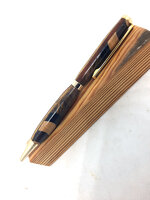
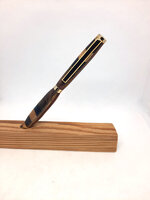
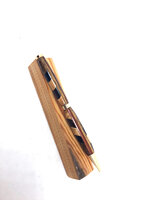
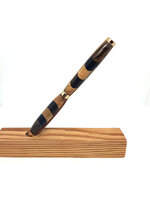
Entry#4 Aluminum and alumilite. I made the front section and cap out of a 1/2 aluminum round bar that I turned on my Rikon 70/100 wood lathe with carbide tools. The blank is made out of alumilite with 1/16 aluminum for the inlays.
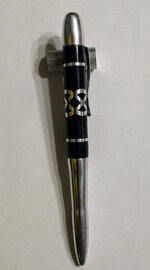
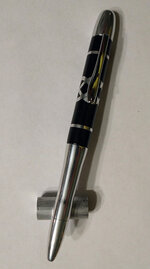
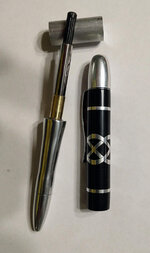
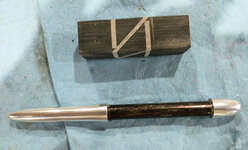
Entry#5 The material you chose to use: Purpleheart on a platinum slimline. A description of the making process: I left out the center band, so I had the freedom to turn the barrels a little thicker at the center. I also lengthened the lower barrel by the width of the band to give proportions of a Euro or cigar pen. After turning and sanding the wood to 600, I cut grooves into the upper barrel and darkened them with a friction burn from a piece of Formica. Then several passes with a propane torch intensified the purple and made it pop. Finished with Gluboost CA medium and thin, using Zona papers and Novus 2 polish to bring out high gloss.
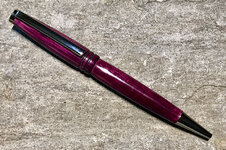
Entry#6 This pen was made of black locust burl and desert ironwood, oiled; usual tubes, tranny, and refill. No animal has been harmed when making it. I did not need any special feature, except some extended drill bits I modified for the nib, and a pin chuck for sanding.
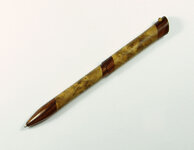
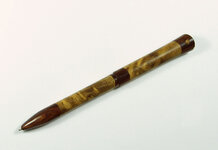
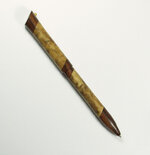
Entry#7 The timber is FIG. Streamline kit buffed with Tripoli and White Diamond and Carnauba Wax.

Entry#8 This is a TiGold nib-twist closed-end slimline in a dyed Box Elder blank with a satin CA finish (4000 micromesh). The square Box Elder blank was submerged with a minwax wood hardner/transtint blue dye mixture for 24 hours to allow penetration into the softer wood grain areas. The blank was then rounded drilled to partial depth on the lathe and then stabilized for extra strength on the thin walls. The blank was then redrilled to full depth on the lathe, turned to shape, and finished with CA. The clip was added using a hidden clip technique. The upper tube was then glued in place, and the lower section parts were assembled and slid into place. A light coat of wax was applied to the lower tube to ensure smooth twist operation.
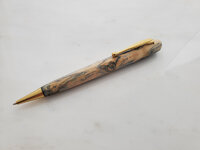
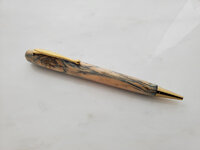
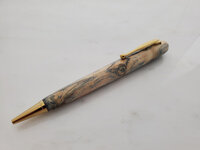
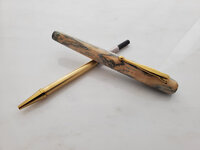
Entry#9 Traditional Archery Arrow Pen. The wood used in this pen came from an old bed frame with a wire mesh top and is Cedar. The tip is a real 125-grain brass arrow point that I have drilled out to accept the Cross refill. I used shield cut 3" feathers which are glued on and tied with artificial sinew. An old-style speed nock is on the top.
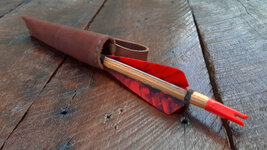
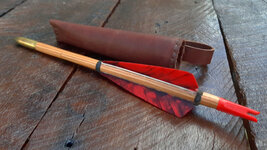
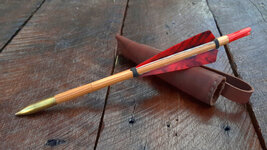
Entry#10 Made from spalted golden shower tree using a slimline transmission and a little longer than normal lower brass tube so it would extend into the nib to give added strength to the nib. The nib, center band, finial, and clip are all made of African blackwood. The clip is all one piece. It was turned as you would a finial, then hand-carved with a razor blade to get the flat back and take off the part that couldn't be turned without removing the part that is glued into the pen. The picture of it is before the bottom was carved flat. Everything was finished with a CA finish.
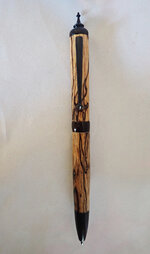
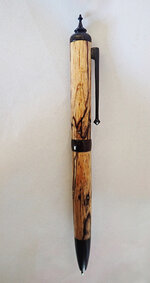
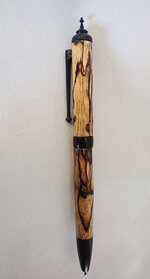
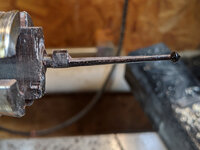
Entry#11 I love the look of these kits and turning them, so I decided to try and take a piece of quilted buckeye burl and replicate the center band to give it a nice contrasting look, yet keep the body flow of the dyed and stabilized maple burl I did here all in house. This is the finished product.
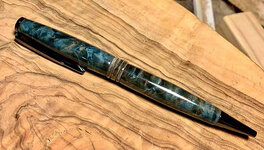
Now scroll back up and vote!
Entry#1 Materials- Cocobolo, red plastic, and dendritic soapstone for the blank, a polaris tip and clip. I glued a 7mm tube inside a Polaris tip and unscrewed it. Then drilled out my blank and glued it on. For the back I used a closed-end mandrel. Gave it all a CA finish.




Entry#2 Acrylic blank and funline kit. My objective was to make a high-end-looking ballpoint pen with a minimum of modifications. My modifications included making the lower barrel longer, eliminating the center band, and carefully developing the contours of the barrels.

Entry#3 PSI Gold Pen kit - the only gold one I had. I have 11 different species of wood in this pen, although you cannot see them all: Cocobolo, Mahogony, Ash, Maple, Bocote, Wenge, Maple, Cedar, Walnut, African Blackwood, and what I think is Yellowheart. For the finish, I used Tung oil, EEE paste, and Pens plus. After I segmented a different pen for a different contest here, I had a thought for another pen. What would happen if I stacked these pieces together. I cut the pieces to 1/4" in width to cover the pen barrel. In hindsight, they were too thick, the end cuts do not show well but they are there. After gluing the pen blank pieces I cut them on a 45. After I was able to get to that point, I took 2 more pieces for the middle. During the turning, I noticed that there was tear-out on several pieces. I took some CA to fill them and what a horrible choice. I had to get it all off and re-finish the 2 blanks with the process above. In my humble opinion, for my 3rd segment pen, I turned out quite well.




Entry#4 Aluminum and alumilite. I made the front section and cap out of a 1/2 aluminum round bar that I turned on my Rikon 70/100 wood lathe with carbide tools. The blank is made out of alumilite with 1/16 aluminum for the inlays.




Entry#5 The material you chose to use: Purpleheart on a platinum slimline. A description of the making process: I left out the center band, so I had the freedom to turn the barrels a little thicker at the center. I also lengthened the lower barrel by the width of the band to give proportions of a Euro or cigar pen. After turning and sanding the wood to 600, I cut grooves into the upper barrel and darkened them with a friction burn from a piece of Formica. Then several passes with a propane torch intensified the purple and made it pop. Finished with Gluboost CA medium and thin, using Zona papers and Novus 2 polish to bring out high gloss.

Entry#6 This pen was made of black locust burl and desert ironwood, oiled; usual tubes, tranny, and refill. No animal has been harmed when making it. I did not need any special feature, except some extended drill bits I modified for the nib, and a pin chuck for sanding.



Entry#7 The timber is FIG. Streamline kit buffed with Tripoli and White Diamond and Carnauba Wax.

Entry#8 This is a TiGold nib-twist closed-end slimline in a dyed Box Elder blank with a satin CA finish (4000 micromesh). The square Box Elder blank was submerged with a minwax wood hardner/transtint blue dye mixture for 24 hours to allow penetration into the softer wood grain areas. The blank was then rounded drilled to partial depth on the lathe and then stabilized for extra strength on the thin walls. The blank was then redrilled to full depth on the lathe, turned to shape, and finished with CA. The clip was added using a hidden clip technique. The upper tube was then glued in place, and the lower section parts were assembled and slid into place. A light coat of wax was applied to the lower tube to ensure smooth twist operation.




Entry#9 Traditional Archery Arrow Pen. The wood used in this pen came from an old bed frame with a wire mesh top and is Cedar. The tip is a real 125-grain brass arrow point that I have drilled out to accept the Cross refill. I used shield cut 3" feathers which are glued on and tied with artificial sinew. An old-style speed nock is on the top.



Entry#10 Made from spalted golden shower tree using a slimline transmission and a little longer than normal lower brass tube so it would extend into the nib to give added strength to the nib. The nib, center band, finial, and clip are all made of African blackwood. The clip is all one piece. It was turned as you would a finial, then hand-carved with a razor blade to get the flat back and take off the part that couldn't be turned without removing the part that is glued into the pen. The picture of it is before the bottom was carved flat. Everything was finished with a CA finish.




Entry#11 I love the look of these kits and turning them, so I decided to try and take a piece of quilted buckeye burl and replicate the center band to give it a nice contrasting look, yet keep the body flow of the dyed and stabilized maple burl I did here all in house. This is the finished product.

Now scroll back up and vote!
